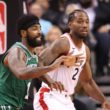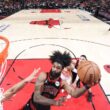“Oh, you are gonna want to do jojoba and sweet almond oil instead of castor,” Whitney White, one of YouTube’s most famous black beauty vloggers, told me over the phone last month. The changing of the seasons was making my hair flake a bit and the castor oil I’d been massaging into my scalp was weighing my hair down. “Add in some aloe,” she says. It was a revelation.
As a young child, the bath was my least favorite time of day because I knew what was coming next: getting my hair combed out. My mother would plop me in front of Jeopardy!, lather a popular pink lotion in my hair, and start in on detangling my tight curls with a wide-toothed comb. When I’d sit down in front of her, she’d say, “I’m ready to fight,” addressing my hair. My mother, who is black, wears her hair naturally and cropped close to her head, but it has a different texture than mine. Each time she combed out my hair, she tried to be gentle at first, but by the end of the show I’d always end up in tears and she’d be calling me tender-headed. “If I even looked at your hair, you’d start crying,” she told me recently about combing my hair. “When you were a toddler I’d cut your hair while you were sleeping so I wouldn’t have to comb it.” How dramatic.
If only my mom had Whitney White, or any of the other massively popular YouTube hair vloggers, to set us up for success. But I was a child of a bygone, pre-internet era.
In 2009, “no one was talking about going natural,” White says. So that year, she started a YouTube channel to chronicle her natural hair journey. “It was a different time back then,” she tells me of the vlogging world. In the 10 years since, she’s amassed more than one million followers and uploaded more than 300 videos about natural black hair, from “I put sweet potato in my natural hair” to “The waterfall french twist.”
Nicole Kimberly Foster, a cultural critic and founder of For Harriet, a blog for black women, notes the social aspect of vlogging.“The [vloggers] did it in a way where you felt like they’re your friends,” she says. Foster, who called the relationship between viewer and vlogger “parasocial,” says people watching the YouTube videos were also “latching onto the likability and accessibility” of the vloggers, thinking of them as “your hair sisters.”
“I liken the natural hair movement of the 2000s to a religious revival,” says Lori Tharps, professor of journalism at Temple University and coauthor of Hair Story: Untangling the Roots of Black Hair in America. And the women who led this natural hair revival would emerge as some of our first social media influencers. Another of the original natural hair YouTube stars, Francheska Medina, agrees: “We changed the landscape.”
In 2009, YouTube was starting to become the behemoth we know today. According to The Atlantic, during that year the video-sharing site expanded its ads to seven different formats, signed a partnership with Disney, promoted video launches, and hit more than 1 billion hits per day. It was also the beginning of an explosive beauty tutorial scene—including a market geared toward people with natural black hair.
According to CNBC, US-based companies are actually missing out on cornering the black hair market. “Most hair care products purchased by African-Americans are imported from countries such as India and China, despite the US having one of the most lucrative hair care markets in the world,” CNBC says. But with the rise of black hair vloggers roughly a decade ago, a new market emerged.
There is Patrice Grell Yursik, who goes by Afrobella and has been called the “godmother of brown beauty,” and Tamara Floyd, whose Twitter profile says “O.G. Natural Hair Blogger 2008.” They were among the first natural hair vloggers and bloggers, and both of them are still active in the beauty and natural hair communities. In 2011, Afrobella partnered with MAC Cosmetics and released “All Of My Purple Life,” a lipglass she created; Floyd still runs an incredibly thorough natural hair information website called Natural Hair Rules.
White says she was inspired to start vlogging after she realized her hair texture was different from what she’d expected once she went natural. “I was expecting my hair to have afro texture,” like most of the other vloggers she was following, “so when my hair came out and it was in an in-between texture consisting of small, tight coils and kinks,” she wasn’t sure how to style it. “I might as well share what I’m learning since I wasn’t seeing the same hair texture as me,” she says. Her first video, entitled “My Natural Hair Journey,” took viewers from her early childhood to the then-present (2009), when she began growing out her natural hair. A content creator named Jouelzy also felt there was a void to fill. “There wasn’t a lot of people [talking about and styling] my hair texture [on YouTube] and so I started doing natural hair videos,” she says. Reviewing wigs was also a big part of Jouelzy’s practice, she tells me.
This group of intrepid hair vloggers brought much more awareness to the many textures of black hair and, alongside it, an entire cottage industry that explains what those textures are, and how to take care of them and style them. The internet taught me that there is a spectrum of textures that go from 1A, which is straight, to 4C, which is coily; it is common for people to be in between different textures, too. These classifications came from a hair typing system created by Oprah’s hair stylist of 25 years, Andre Walker. He tells me the internet is “why [my chart] spread.” (The chart first appeared in his book Andre Talks Hair!)
The internet catalyzed the natural hair boom of the mid 2000s, driving a different cultural moment than natural hair movements that came before.
Of course, black women have been wearing our hair natural since the dawn of time. But a major change happened in the 1800s, when the hot comb—a literal comb heated on an oven—was invented. Women used this device for years (and the straight iron persists as a continuation of the concept), but as beauty products became a commercialized enterprise, Tharps points out, the offensive ways companies advertised to black women began to reach a boiling point. “Black women were tired of being treated like dirt with marketing and sales campaigns that made women feel like they were destined to fail, or that they were animalistic,” she says. That’s why one of America’s first black millionaires, Madam CJ Walker, knew she had a market by creating her own line of hair care products for black women—including salve for hair growth—at the turn of the 20th century. George Johnson, of Ultra Sheen and Afro Sheen fame, would follow in Walker’s footsteps in the 1950s by starting his own hair care line, Johnson Products, that would eventually be one of the first black-owned companies to be listed on the stock exchange.
Then, during the black power movement of the ’60s and ’70s, natural hair became a front-and-center statement. As Tharps points out, black women of that time (and since) carried the burden of needing to outwardly politicize their beauty, as opposed to white women who have the luxury of styling or cutting their hair in ways that will never be interpreted as activism. When my mother was growing up in Philadelphia in the ’50s, she used, like many of her peers, a hot comb on her hair to make it straight. It wasn’t until right after she graduated from college in the mid ‘60s that she decided to go natural. Her best friend encouraged her to perm. “I was so disgusted with the cost of upkeep that I shaved my head totally bald,” she says. She hasn’t changed it since. My mother says her decision was never a political one, but a maintenance one. She simply didn’t care for upkeep.
This history is what makes the recent natural hair movement—and the vloggers who ushered it in—so notable. “Whereas in the ‘60s and ‘70s men and women were using their hair as a political statement, the natural hair movement of the aughts is about beauty,” Tharps says. “It really was revolutionary to see twist outs, dreadlocks, and braids without people necessarily trying to make a statement.” This is why, Tharps says, “For black women to have a movement around beauty is revolutionary.”
While the “hair girls,” as Medina lovingly calls them, of the aughts were hugely instrumental in spreading information about styles and hair care, they certainly were not the first to use the internet to share knowledge. In the early days, “there were a lot of hair forums,” she says, adding that threads were categorized based on what information you were looking for. Then, “Twitter came in the game” and changed everything. “It was a faster way to get the information you needed,” she says. Medina spent whole days fielding and answering questions. Pop culture was also an influence, says Whitney White. “The natural hair community was definitely inspired by musicians such as India.Arie, Lauryn Hill, Erykah Badu.”
Tumblr was an important part of the robust natural hair dialog. The microblogging website was a space where users began to engage and share inspirational images and blog posts about natural hair. “We all carved out our lanes,” Medina says. “Mine was focused on health,” because, she says, her hair had fallen out after an illness.
“Even on the street they call us the OG internet girls,” says Medina. “We kicked it off in terms of the natural hair boom.” The YouTube natural hair explosion hit amid influencer culture. The OGs were making money. Then in 2013, she says, “we all signed to Maker Studios” a once-famous multi-channel network. “It was a big deal.”
The popularity of hair tutorials, and vlogging more broadly, indicated to companies that there was money to be made—and the YouTubers were a big part of that monetization, Tharps says. Medina agrees. “The brands started taking over [the YouTube] space and paying $10,000 to $50,000, money I never saw in my life,” she says about the 7-minute videos she created. “It just really changed the game.” After Medina began monetizing her videos, she put much more work into them. “It upped the stakes,” she says. “You wanted your cam to be better and you’re learning Final Cut Pro because you want the editing to be better,” she says, adding to those skills a fluency in Adobe and purchasing a DLSR. “I invested in camera equipment and said I was going to do natural hair videos that make 4C hair look beautiful,” says Jouelzy, comparing her approach to other tutorials she had seen.
But there was, as Jouelzy wrote in a piece for Ebony (and in a video that she has taken down from public view on YouTube), a lamentable side of the natural hair community: texture discrimination. “The [natural hair community] continues to promote the idea that healthy natural hair is curly, it’s shiny, it’s laid full of baby hairs and that that’s the pinnacle for what healthy, natural hair should look like. That leaves such a large audience of women out who are natural who might feel like they’re doing something wrong with their hair because their hair doesn’t look like what’s being represented in the natural hair community,” she says in her video. “It’s not just about skin color,” Jouelzy tells me. “It is about a European spectrum of beauty.” Foster agreed, adding, “We equate light skin to having curly hair, finer hair, slimmer features, smaller features. And that’s not always the way that it plays out.”
“It was a specific type of natural that was getting the attention,” Medina says, adding that she was always mindful of these issues and found it was “a lot to reconcile, especially as the space got bigger in terms of who was getting the fame and financial stability.”
One of the benefits, Foster says, of this “growing cadre of influencers, public intellectuals, bloggers, and tweeters” is that an opportunity has opened up to “cut deeper to get to some of those layers that we’ve just kind of been glossing over” when it comes to blackness and beauty. “There’s still a lot to be done, but I do think the conversation is happening a lot more now,” she says, adding that we are seeing more representation. The conversation is ongoing, but simply continuing to have a public discourse about the issues of texture discrimination in hair care and beauty is a vital step in pushing representation forward.
And more representation went beyond our computer screens. “Products started out as mail orders, and eventually were on Target shelves,” says Tharp. One black hair blogger, Leila Noelliste, opened her own store in the Bedford-Stuyvesant section of Brooklyn. Seeing “top-of-the-line, luxurious, beautifully scented, colorful, and indulgent” natural hair products geared toward black women in retail stores “cemented this natural hair movement that continuously grows and expands,” Tharps says. “Black women can be as indulgent as white women when it comes to choosing products, so much so that women who aren’t black are enticed.”
The OG hair girls who helped launch this retail and cultural success further capitalized on it. “People have their own hair care lines now,” says Medina. Her friend and major vlogger Franchesca Ramsey, known as Chescaleigh, wrote a book and catapulted into the TV world and now has her own show on MTV. Medina has a podcast, The Friend Zone, and also hosts a podcast about the HBO show Insecure called Insecuritea. “It’s interesting,” Medina says, “to see how that propelled our careers just by talking about our hair.” Jouelzy, for her part, weaves history into her cultural commentary on YouTube and is planning to apply for a PhD in history.
As for the natural hair movement of the mid-aughts, it has sort of “plateaued,” says Medina. Though there is still a very active natural hair community, makeup has become a significant draw on YouTube (you only have to look at how much media attention the James Charles fracas received). “I felt the natural hair community was limiting because there’s only so many people who can watch those videos,” says beauty blogger Alyssa Forever, who has more than 1.3 million subscribers to her YouTube channel. “I want all people to watch, not just people with certain hair texture as me,” she says. “Makeup and beauty is so diverse.” Jouelzy notes that makeup tutorials have been around since the beginning, but because of the money poured into YouTube, vloggers now enjoy a different level of success. “There will always be a need for women to talk about natural hair and celebrate natural hair as long as white supremacy is a thing,” Foster says, agreeing that the community has expanded to include Instagram and makeup.
But, for those who are still in the natural hair game like Whitney White—who also does beauty vlogging—hair denotes something about the self. “It’s just hair but it’s more than that. Every culture has held meaning in hair. It’s an identifier and gives a lot of people a lot of pride,” White says. “When you feel better about your hair you have a better day. Once we were comfortable about our hair, once we were finally loving our hair in whatever way we choose to wear it, it opened the doors to loving other things as well.”
More Great WIRED Stories
- Bitcoin’s climate impact is global. The cures are local
- Fans are better than tech at organizing information online
- Gritty postcards from the Russian hinterland
- What does it mean when a product is “Amazon’s Choice”?
- My glorious, boring, almost-disconnected walk in Japan
- ? Things not sounding right? Check out our favorite wireless headphones, soundbars, and bluetooth speakers
- ? Want more? Sign up for our daily newsletter and never miss our latest and greatest stories
Source:WIRED




